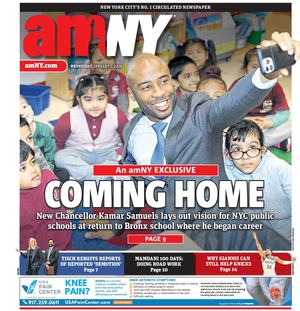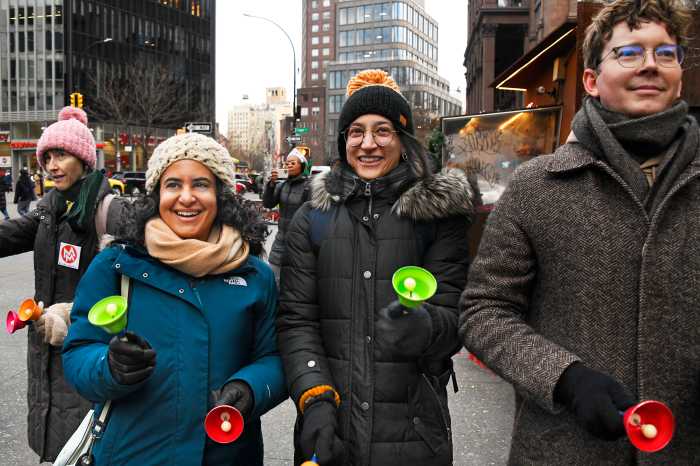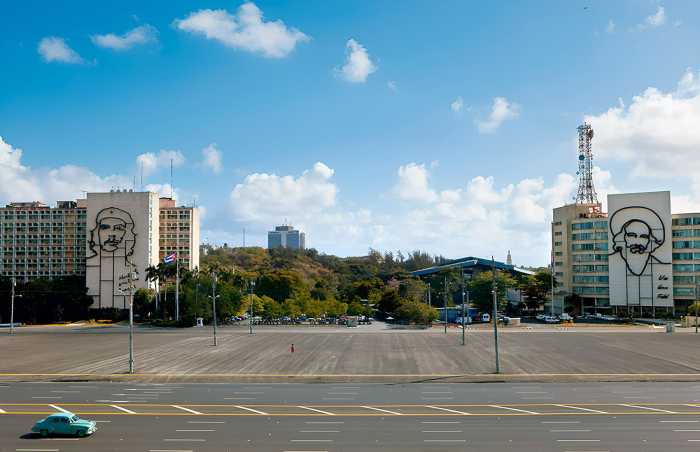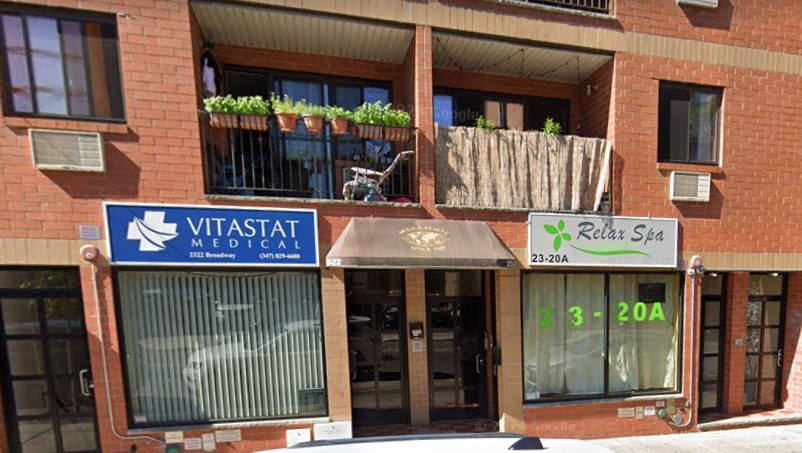By Lincoln Anderson
Last December, 150 community members and the area’s politicians from all levels of government rallied in front of the Fiorello LaGuardia statue to send New York University a resounding message: “Hands off the strips!”
N.Y.U. officials say the university definitely heard them. As a result, the university is now working to ensure that two block-long parcels of Department of Transportation-owned property — a pair of the so-called “strips” — are transferred to ownership of the Parks Department.
However, N.Y.U. says it still needs to preserve the ability to access or even dig through the strips, if need be — known as easement rights.
As part of its plan to add space on its two South Village superblocks, N.Y.U. originally had sought to purchase from the city seven of the strips of land that were left over from Robert Moses’ aborted Lower Manhattan Expressway and street-widening project in the mid-20th century. Now, however, the university is only seeking to buy two of the strips.
Meanwhile, the school is actively working to have Parks purchase the two strips on the west and east edges of its northern superblock, on Mercer St. and LaGuardia Place between Bleecker and W. Third Sts.
“We feel this is a response to what the community and elected officials want,” said Alicia Hurley, the university’s vice president for community engagement and government affairs. “This should be seen as a win: The community gets the strips and N.Y.U. gets to grow.”
“We don’t need the land,” added Lynne Brown, N.Y.U. senior vide president. “We’re not hegemonic that way if we don’t need it for what we need to do.”
The two strips that N.Y.U. does want, the officials said, it needs for its development plan, as well as for its power needs. Specifically, the university wants to acquire the Mercer St. strip on the southern superblock’s east edge, which is currently home to the Mercer-Houston Dog Run. Under the school’s growth plan, the current Coles Gym would be razed, to be replaced by a new building, for now dubbed the “Zipper Building” due to its zigzag design when viewed from above.
N.Y.U. wouldn’t expand the gym’s current footprint, but wants to shift this footprint east onto the Mercer St. strip. Doing this would open up space on the new building’s west side for a widened pathway on what used to be Greene St. before that street was demapped to create the superblock, leaving a little-used alleyway there. The building has to be shifted east onto the strip because it wouldn’t work with a dog run right in front of it, Hurley said. Coles Gym doesn’t have windows, so it’s O.K. to have a dog run there now, she said.
The “Zipper Building” will have a new gym, student residences, a supermarket, faculty residences and an N.Y.U. hotel. It will have 800,000 square feet aboveground and 200,000 belowground.
The dog run’s president, Beth Gottlieb, has said that moving it next to Silver Towers will be a problem, especially at night, because of the dogs’ barking. But Hurley said there are ways to mitigate the noise, such as by strategically planting trees.
The other strip the university covets is two blocks north on Mercer St. between W. Third and Fourth Sts., below which its recently rebuilt and expanded co-gen plant is located and to which the university says it needs to preserve access. N.Y.U. recently built a new park and seating area on the strip above its co-gen plant.
Even though Parks would take over the two strips on the northern superblock, N.Y.U. says it needs to preserve an easement on these areas because it plans to build four stories’ worth of space underneath them — or 80,000 square feet of space under each strip.
For example, Hurley said, “If a membrane [for the underground space] had a leak in 50 years, we would want to be able to fix it.”
In other words, the university conceivably might sometimes need to do construction or repair work that would involve digging down through these parks. If N.Y.U. carries out its development plans on this northern superblock, it would also need to move construction equipment over these park strips, which might also be used as construction staging areas at that time, Hurley acknowledged.
The other major change to N.Y.U.’s superblocks development plans is another concession to the “Hands off the strips!” community backlash. Namely, in the latest designs, the larger of two infill buildings the university plans on the northern superblock has now been shifted 15 feet west, so that it no longer sits on the city-owned Mercer St. strip.
Pretty much everything else about the plans is unchanged from the most recent round of presentations to the community.
For example, on the southern superblock, N.Y.U. still is committing to allowing the School Construction Authority to erect a seven-story, 100,000-square-foot school building for 600 to 800 students on the site of the current Morton Williams supermarket. N.Y.U. would not charge the city anything to do this. Hurley noted the university had paid $23 million to acquire this site.
In turn, N.Y.U. will eventually decide whether, as part of the project, it will build a student dormitory on top of this city public school. From 1,000 to 1,400 undergraduate students — freshman and sophomores — will be housed in up to two locations on the southern superblock.
On the northern superblock, the plan still calls for two boomerang-shaped infill buildings. In all, under its plan, N.Y.U. would add 1.3 million square feet aboveground and 1 million square feet belowground on its two supersized blocks.
Hurley said N.Y.U., in conceding the two strips in question to Parks, had been responding directly to four community groups: the dog run, the Friends of LaGuardia Place (which maintains the LaGuardia Place strip between Bleecker and W. Third Sts.) LMNOP (which got the Mercer St. playground built) and the LaGuardia Corner Garden. Discussions are still ongoing, mainly through a lawyer who is acting as the four groups’ “ambassador” to N.Y.U., she said.
“Obviously, we have a way to go with these groups,” she said.
There won’t be any fences on the park strips, Hurley said, though adding, “But we’re of course going to have rules.”
Under the plan, N.Y.U. will be opening up the massive interior courtyard of its northern superblock to public access.
“Some of our faculty who are tenants of Washington Square Village [on the northern superblock] are concerned about this becoming a big, open park like Washington Square Park,” Hurley said. “We want to have power to say it’s closed at midnight.”
N.Y.U. doesn’t want control over the strip on LaGuardia Place between Bleecker and Houston Sts., which is home to the LaGuardia Corner Garden and the Time Landscape.
In terms for its construction timeline, N.Y.U. foresees, once approvals are in place, starting work on the southern superblock first. Work would continue there until 2021. Construction for phase two — the northern superblock — would occur between 2022 and 2030.
The university’s first incarnation of the superblocks plan included a 40-story tower in the Silver Towers complex that would have been the tallest in the Village. The target of intense community opposition, it was eventually scrapped after I.M. Pei, Silver Towers’ architect, said he strongly disapproved of it.
The N.Y.U. representatives said the university’s trying to grow on its own superblocks is an attempt to do the right thing.
“This process started with the E. 12th St. dorm and people were saying, ‘Stay out of our community,’” Hurley said.
“This is a response so N.Y.U. can grow,” Brown reiterated, adding, “We’re not going to the Financial District. We are doing stuff in Brooklyn.”
John Marino, a P.R. representative for N.Y.U., said the mapping application for the massive project will be submitted to the city next week, with the draft ULURP (uniform land use review procedure) to follow about two weeks after that.
In addition, N.Y.U. recently commissioned a telephone poll by Global Strategy Group to gauge New Yorkers’ feelings about the university. Six hundred registered voters were surveyed. The findings were that 70 percent of voters support N.Y.U.’s plans to grow, “even in the historic West Village.” However, only 62 percent of Manhattan voters supported N.Y.U.’s expansion plans. In addition, 54 percent had a “strongly favorable” view of N.Y.U., while 27 percent had a “somewhat favorable” opinion and 6 percent an “unfavorable” opinion. According to the pollsters, the survey has a margin of error of plus or minus 4 percent.
Asked why the university didn’t just survey voters in the zip codes around the Village, the N.Y.U. officials said N.Y.U. is a “citywide university” and that the university’s “NYU 2031” strategic growth scheme is a “citywide plan.”
They conceded that a more locally focused poll would predictably find much greater opposition.
This article lays out the latest updates in N.Y.U.’s superblocks development plan. It will be followed promptly by an article with reaction from the community.






































